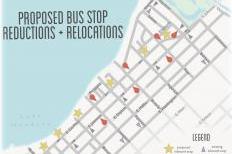






 Map by Natalie Amend--The Bus Stops Here is produced monthly by members of Madison Area Bus Advocates
Map by Natalie Amend--The Bus Stops Here is produced monthly by members of Madison Area Bus Advocates
Eliminating bus stops in an effort to speed up bus travel is all the rage these days, on a par with the fad of five plus years ago that resulted in bus windows being covered with advertisements. And Madison should be with it, right? Just like when the fad was to put freeways through the middle of town? Everywhere one turns, eliminating bus stops is among the top recommendations for how to speed up bus travel.
I wish that everywhere I turned, I saw attempts to avoid doing something that is socially divisive and a continuation of Metro’s downward spiral. This so-called improvement is nothing more than a pathetic attempt to minimize damage caused by the under-funding of a utility that should be getting much better public support. Yes, the buses are slow. That is easy to document. But eliminating bus stops reduces accessibility while encouraging yet more people to give up on them, get a car instead, further clog streets and yes, slow buses down even more.
The older parts of Madison have bus stop placement much closer than the supposed ideal spacing of a quarter mile apart and the recently adopted five-year Transit Development Plan calls for them to be radically thinned out, sometimes to as few as half as many as there are now. Metro is enthusiastically doing just that, most recently as part of the reconstruction of E. Johnson St. A Shock Doctrine for bus stops? Thinning out the bus stops on Jenifer St., Monroe St., and University Ave. will not be far behind.
Ever wonder why stops were placed so close together in the first place? Because placement reflected dense settlements of a human scale at a time when planners did not have to worry about private automobiles both clogging up roadways and being given the right-of-way when doing so.
When buses come by frequently, nobody is actually waiting at most bus stops, and buses can just pass them by while leaving them for when someone does need to use them. Likewise, if buses did not have to share travel lanes with many cars, either because there weren’t many cars there or because buses had the right-of-way to re-enter traffic, they could also be much faster. So it would be most logical to speed up bus travel (and be more economical) by returning urban development to the denser grid system, increasing bus frequency and modifying traffic law to favor bus, foot and bicycle travel, right? Unfortunately, not according to what has become conventional wisdom. Conventional wisdom?
State government controls most traffic law, including the determination of right-of-way, and current Wisconsin traffic law gives special consideration to school buses but not city buses. City buses are required to wait until all cars have passed before re-entering the traffic lane.
Any idea of how much time is wasted waiting for cars to pass? No. Engineers have elegant models calculating how much time is used to stop (decelerate, stop, accelerate etc.) rather than just continuing to drive, but they have no estimate for the average time a bus must wait because of traffic and the right-of-way law. If they did, I think they would be impressed.
Apparently, others think so too because traffic law in Minnesota and a few other states, gives city buses the right-of-way to re-enter traffic after pulling over to the curb at a bus stop. So is adopting Minnesota’s right-of-way law one of the first items on lists for “how to” speed up bus travel? Unfortunately, no. In fact, some lists do not even mention the issue.
Since traffic law is determined on the state level, and Metro must function on the local level, what can be done on the local level, at least in the short term? How about having runs that simply skip over stops that can be used by other runs? Metro is already doing that and could expand the practice without having to physically remove a stop as well. The runs doing that now of which I am most familiar are the #56 and #57 in Madison and the #71 and #72 in Middleton. Those buses only operate during peak (rush) hours in the morning and late afternoon and they are called “limited stop” runs. In places serviced by other buses, they may travel up to a mile between stops. Skipped stops are not eliminated but rather are used by other buses that traverse the area more slowly.
In an ideal world, buses would run so frequently and be so unimpeded by traffic that no one would even think about bus stop elimination. That obviously is not the situation currently being faced here in Madison. But let’s move toward the ideal, not away from it. Instead of eliminating bus stops, have certain runs just skip them. Leave them in place for buses runs and for a human-scaled future.
|
|
|
Welcome to the Madison Commons, a website designed to provide news and information about all of Madison's neighborhoods and a crossroads for the discussion of community issues. The name comes from the idea of a village commons, a place for news, talk, debate, and some entertainment, too, that's open to everyone.
All rights reserved. Read more about the Madison Commons and its partners.

